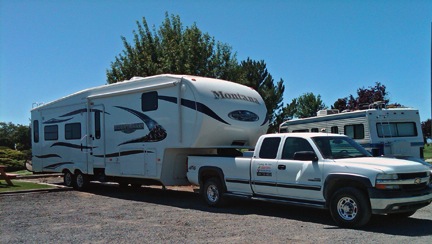It is, after all, a mobile mansion.
Yesterday, I repositioned my fifth wheel RV, the “mobile mansion,” from an RV park at the Colockum Ridge Golf Course in Quincy, WA to a residential construction site high on a hill on the east side of Squilchuck Valley. The site is across the street from an 86-acre orchard I’m responsible for drying with my helicopter after it rains for the next few weeks.
The Move
Moving an RV you’ve been living in for two months isn’t as easy as just hooking up and rolling out. The first step is to put away all the loose objects you’ve been living with for that time — loose objects will get tossed around in transit. I had to stow my desktop computer in its box to protect it, clear my desk and table and kitchen countertops, stow shelf items — the list goes on and on. Even the small tabletop lamp beside my La-Z-Boy rocker needed to be stowed.
Of course, since I was putting things away, I felt compelled to dust and vacuum. The benefit is that when I arrive at my new parking spot, my home will be clean.
Then comes strapping down the items that can’t be stowed: my swing-arm mounted 36-inch HDTV, the La-Z-Boy, and Alex the Bird’s cage. The RV comes with straps for all of these things. (Alex’s cage sits where the second La-Z-Boy would be.)
Outside, I needed to take down my windsock and its 14-foot pole. (I had to use pipe wrenches to get the three pipe segments separated.) Stow the bird feeder and grill. Take down the outside sun shades, hose them off, and hang them to dry — then stow them when dry. Roll up the awning. Dump the gray and black water. Wash and stow the sewer hose. Disconnect the water and power and stow the hoses and cables.
Use the remote to slide in the RV’s four slides, raise the stabilizer legs, and lower the landing gear. Back the pickup into position — by myself, mind you — and raise the landing gear to drop the hitch on top of the ball. (Yes, this is a fifth wheel trailer, but we put a gooseneck adapter on it since we already had a gooseneck hitch in the bed of the pickup.) Fasten the pin, chains, and power cord.
 I use an app on my iPad to list and check off the things I need to do. It’s called RV Checklist and although its not as slick looking as a typical iOS app, it does give me the ability to create and use custom checklists. The benefit: I can include items like “Take down windsock” and “Secure bird cage,” which are not likely to appear on any standard check list. I can also remove items I don’t need, such as “Disconnect satellite dish” and “Hook up towed vehicle.”
I use an app on my iPad to list and check off the things I need to do. It’s called RV Checklist and although its not as slick looking as a typical iOS app, it does give me the ability to create and use custom checklists. The benefit: I can include items like “Take down windsock” and “Secure bird cage,” which are not likely to appear on any standard check list. I can also remove items I don’t need, such as “Disconnect satellite dish” and “Hook up towed vehicle.”
On the Road
 Once the trailer was hooked up and the chocks were collected and stowed, I loaded my potted tomato plant and Alex the Bird into the truck and headed out.
Once the trailer was hooked up and the chocks were collected and stowed, I loaded my potted tomato plant and Alex the Bird into the truck and headed out.
Driving a 3/4 ton pickup with a 34-foot fifth wheel trailer behind it isn’t something to be taken lightly. Every turn needs to be considered. Every downhill slope needs to be approached with care. And driving in city traffic can really pump up stress levels.
My drive wasn’t long — only about 50 miles. The first 35 miles was two-lane state highway with little traffic, 60 miles per hour speed limit, and passing lanes every 5 to 10 miles. Easy going. The next 5 or so miles, however, was city driving through East Wenatchee, over the Columbia River, and into Wenatchee. This is tense stuff for me because, with my load, driving defensively is not much of an option. I have to keep to my lane and hope no one around me drives like a jerk. Then the final 10 or so miles was up windy canyon roads. Yesterday was a special challenge — a detour onto a narrower, windier road. Fortunately, traffic wasn’t an issue.
After two turns, I climbed up the last road to my destination. The pavement turned to fine gravel. A quarter mile later, was the circle of a former cul-de-sac, now with a narrow dirt road leading farther up the side of the valley. My parking spot was a sharp right turn down a steep dirt hill. Since I’d be backing into it, I pulled up into the far side of the cul-de-sac and got out to set my cones.
Parking
I have a trick I use to back up the RV by myself. I have four small orange traffic cones. I set them out as guides to where I want to park the RV. I can clearly see them in my side view mirrors. All I have to do is line up the side of the RV with the cones and I can get it into position.
Of course, this site required quite a lengthy roll back. As a result, I had to set the cones out once, back almost all the way to the last one, and then get out of the truck and set the cones again. The last little bit was particularly challenging, since I’d be positioning the RV between the edge of a cliff and the home under construction. I managed to get it in place without too much difficulty — this surprised me because, by that point, I was completely exhausted. I’d been on the move all day and it was about 6:30 PM.
Before disconnecting, I needed to make sure the RV was level. After consulting the level right inside the RV’s door, I decided that three leveling blocks would do the job. I positioned them and rolled the RV back on top of them. Although I probably could have been a bit more level with just two blocks, this was good enough. Besides, I knew from experience that if it rained, the blocks would sink a bit into the ground beneath them. That would likely make me perfectly level.
Then lower the landing gear, disconnect the hitch and its chains/cable, and pull the truck out. Raise the landing gear to level the RV. Slide out the slides. Good to go. I’d pull out the things I needed as I needed them over the next few days.
Later, after a shower to wash away the day’s dirt and sweat, I ran a power cord to the 110 volt outlet on the homesite’s electric box. This power connection is a far cry from the 50 amp power supply at the campground. I know I won’t be able to run certain appliances at the same time — for example, the microwave and air conditioner. But at least I won’t have to rely on the RV’s solar panel or run the generator for power.
My Campsite
I stayed here last year for the first time. Back then, the only sign of construction was a building foundation and the concrete pouring forms that had been used to make it. This year, there’s a small, two story vacation home framed out and roofed. The siding should go on this week; the windows, which have been delivered, will go up soon, too. Then construction will stop for the season. The owner of the property is paying for construction as it is completed and he says he’s out of money.
A time-lapse movie I shot last year from this spot.
My parking spot is literally on the edge of a cliff — the ground drops off about 10 feet past my door. The views out the side and back window are spectacular. Across the valley are scattered pine trees, granite rock outcroppings, and orchards. Sunrise is amazing; golden light creeping down the hillside. And back toward Wenatchee, I can see the Columbia River and Rocky Reach Dam, which are all lit up at night.
 My helicopter is parked down in the orchard. I tried to park it near my campsite, but I couldn’t find a piece of ground level enough to make me comfortable leaving it there. I might try moving it again later today — I really don’t like it being out of sight. Wish I could get my hands on a Bobcat for a few hours to level out a piece of this hilly homesite.
My helicopter is parked down in the orchard. I tried to park it near my campsite, but I couldn’t find a piece of ground level enough to make me comfortable leaving it there. I might try moving it again later today — I really don’t like it being out of sight. Wish I could get my hands on a Bobcat for a few hours to level out a piece of this hilly homesite.
I wonder what will happen next year. Will the house be done? Will the owner tell me that there’s no room for an RV in his side yard? Will I be parked down in the orchard beside my helicopter and the scummy pond, hauling fresh water and running a generator every day? I hope not. But I won’t worry about that now. I’ll just enjoy this year’s hillside campsite.
Today, I’ll hook up the water connection and set up the gray water to drain away from the RV. (I’ve already switched to biodegradable soaps to minimize impact.) Then I’ll head down to Wenatchee and do some shopping.
I’m glad I’m up here. Although this location is lonely and remote at night, there’s activity during the day on the house construction nearby and on the orchard. And I can’t imagine a more pleasant place to park.

 Pie crust dough, phyllo dough, or puff pastry sheets. A purist would make pie crust from scratch. I’m living in an RV with limited kitchen facilities, so that’s not really an option for me. Besides, I make really crappy pie crust from scratch. Someone with slightly less ambition might use frozen phyllo dough to make a flaky base for the turnovers. I’m not that ambitious. Instead, I used frozen Pepperidge Farm Puff Pastry Sheets.
Pie crust dough, phyllo dough, or puff pastry sheets. A purist would make pie crust from scratch. I’m living in an RV with limited kitchen facilities, so that’s not really an option for me. Besides, I make really crappy pie crust from scratch. Someone with slightly less ambition might use frozen phyllo dough to make a flaky base for the turnovers. I’m not that ambitious. Instead, I used frozen Pepperidge Farm Puff Pastry Sheets. Spoon about 1/4 cup cherries into the middle of a pastry square. Then fold diagonally and seal by pinching two open sides. It’s important to get a good seal if you want the cherries and their juices to stay inside the turnover. Repeat for remaining squares and cherries.
Spoon about 1/4 cup cherries into the middle of a pastry square. Then fold diagonally and seal by pinching two open sides. It’s important to get a good seal if you want the cherries and their juices to stay inside the turnover. Repeat for remaining squares and cherries. Place turnovers on a lightly greased cookie sheet. (Again, with my limited kitchen facilities, all I had was a pizza pan, which would not fit all eight, so I had to make them in batches.)
Place turnovers on a lightly greased cookie sheet. (Again, with my limited kitchen facilities, all I had was a pizza pan, which would not fit all eight, so I had to make them in batches.) Yields: 8 turnovers.
Yields: 8 turnovers.
 Pie crust dough, phyllo dough, or puff pastry sheets. A purist would make pie crust from scratch. I’m living in an RV with limited kitchen facilities, so that’s not really an option for me. Besides, I make really crappy pie crust from scratch. Someone with slightly less ambition might use frozen
Pie crust dough, phyllo dough, or puff pastry sheets. A purist would make pie crust from scratch. I’m living in an RV with limited kitchen facilities, so that’s not really an option for me. Besides, I make really crappy pie crust from scratch. Someone with slightly less ambition might use frozen  Spoon about 1/4 cup cherries into the middle of a pastry square. Then fold diagonally and seal by pinching two open sides. It’s important to get a good seal if you want the cherries and their juices to stay inside the turnover. Repeat for remaining squares and cherries.
Spoon about 1/4 cup cherries into the middle of a pastry square. Then fold diagonally and seal by pinching two open sides. It’s important to get a good seal if you want the cherries and their juices to stay inside the turnover. Repeat for remaining squares and cherries. Place turnovers on a lightly greased cookie sheet. (Again, with my limited kitchen facilities, all I had was a pizza pan, which would not fit all eight, so I had to make them in batches.)
Place turnovers on a lightly greased cookie sheet. (Again, with my limited kitchen facilities, all I had was a pizza pan, which would not fit all eight, so I had to make them in batches.) I use an app on my iPad to list and check off the things I need to do. It’s called
I use an app on my iPad to list and check off the things I need to do. It’s called  Once the trailer was hooked up and the chocks were collected and stowed, I loaded my potted tomato plant and Alex the Bird into the truck and headed out.
Once the trailer was hooked up and the chocks were collected and stowed, I loaded my potted tomato plant and Alex the Bird into the truck and headed out. My helicopter is parked down in the orchard. I tried to park it near my campsite, but I couldn’t find a piece of ground level enough to make me comfortable leaving it there. I might try moving it again later today — I really don’t like it being out of sight. Wish I could get my hands on a Bobcat for a few hours to level out a piece of this hilly homesite.
My helicopter is parked down in the orchard. I tried to park it near my campsite, but I couldn’t find a piece of ground level enough to make me comfortable leaving it there. I might try moving it again later today — I really don’t like it being out of sight. Wish I could get my hands on a Bobcat for a few hours to level out a piece of this hilly homesite. We went to
We went to  It wasn’t long before I bought my next bike, a 1996 Ducati 900 SS/CR. Now here was a bike with testosterone. I recall trying to find the top end one day on a piece of long, straight desert road. I got to 130 mph when I decided that I didn’t really need to find the top end. Needless to say, I had no trouble keeping up with the group.
It wasn’t long before I bought my next bike, a 1996 Ducati 900 SS/CR. Now here was a bike with testosterone. I recall trying to find the top end one day on a piece of long, straight desert road. I got to 130 mph when I decided that I didn’t really need to find the top end. Needless to say, I had no trouble keeping up with the group. It arrived on Thursday, on a specially designed dolly in a 18-wheeler filled with motorcycles. I took possession about half a mile down the road from my temporary home, at a closed-down weigh station. I’d asked Mike to put on the Givi hard luggage I’d bought for it; the helmet and my old denim riding jacket were stowed inside. Once I remembered how to start it — I knew there was a primer switch somewhere but couldn’t remember where at first — I was good to go.
It arrived on Thursday, on a specially designed dolly in a 18-wheeler filled with motorcycles. I took possession about half a mile down the road from my temporary home, at a closed-down weigh station. I’d asked Mike to put on the Givi hard luggage I’d bought for it; the helmet and my old denim riding jacket were stowed inside. Once I remembered how to start it — I knew there was a primer switch somewhere but couldn’t remember where at first — I was good to go.